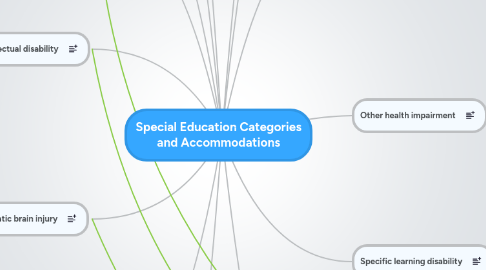Special Education Categories and Accommodations
Door Tom Eminson


1. Deaf-blindness
1.1. Deaf-blind students face unique challenges, They learn by doing, which makes small group or individual work ideal. Safety accommodations must be considered, to remove potential hazards from the classroom.
1.2. Some learning materials for deaf-blind students are presented in this video.
2. Deafness
2.1. A range of accommodations can be made for students with hearing impairments and deaf students with cochlear implants.
2.2. Students with deafness or hearing impairments may require communication accommodations such as: Specialized seating arrangements Enhanced speech reading conditions Clear enunciation
3. Developmental delay
3.1. Useful interventions for students with developmental include developing routine and predictability: Following a routine for starting a lesson or changing activities help the student to prepare independently. Setting a clear schedule for activities and using visual timers can help students plan and manage their time.
4. Hearing impairment
5. Intellectual disability
5.1. Students with disabilities that affect their cognitive abilities will benefit from assistive technologies like multi-sensory tablet apps for practicing verbal and mathematical skills.
5.2. Accommodations and instructional strategies for students with mild intellectual disability are presented in this video.
6. Traumatic brain injury
6.1. Students with traumatic brain injury often have difficult with memory and organizational skills. Some interventions include: Labels and post-it notes Calendars and planners A memory notebook that "may contain maps, checklists, feelings log, and other information (e.g., telephone numbers, names of contact people)"
7. Visual impairment, including blindness
7.1. For visually impaired students reading from the board is a big problem. A tablet can be used to get a closer look at what's on the board.
7.2. Visually impaired and blind students will require material accommodations such as: Materials in Braille or large print Tactile graphics Audiotapes Manipulatives and tactile objects for demonstrating visual concepts
8. Autism
8.1. An effective intervention which adapts a student's own coping strategy for stressful situations in a discreet way for the classroom.
8.2. Assistive technologies for students with autism include apps such as: Story Land Inspiration Maps Injini Child Development Game Suite Flashcard Maker by Inkids My PlayHome Stores
8.3. Applied Behavior Analysis is used effectively in this video to help students on the autistic spectrum.
9. Emotional disturbance
9.1. Students with emotional disturbance may need interventions that focus on social skills: Modeling appropriate behaviors Teaching strategies like 'stop and think' to improve interactions Conflict resolution skills
10. Multiple disabilities
10.1. Students with multiple disabilities will have varying needs depending on the combination of disabilities.
10.1.1. A clip from the documentary Going to School shows a student with multiple disabilities accommodated in a LRE.
11. Orthopedic impairment
11.1. Students with orthopedic impairments can benefit from physical classroom accommodations that provide: Frequent changes in positions Extra space Rounded or soft desk edges Regular breaks Access to water Time for bathroom visits
11.2. Jonathan Francis has excelled in a LRE in spite of his orthopedic impairment. He prefers assistance from his peers to classroom modifications, highlighting the importance of student choice in special needs provisions.
12. Other health impairment
12.1. As a 'catch-all' category of disabilities, students with other health impairment may require numerous different accommodations and modifications.
12.1.1. For students with ADHD, classroom accommodations should help keep the student's attention focused on the lesson: Seat at the front of the class or away from distractions Break up assignments into smaller parts Encourage the student to get involved in presenting the lesson to keep them engaged

